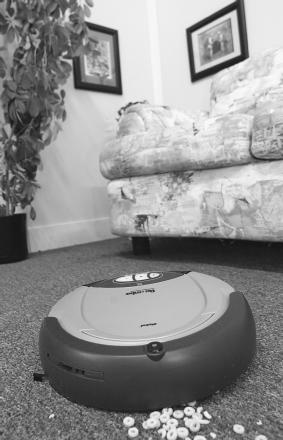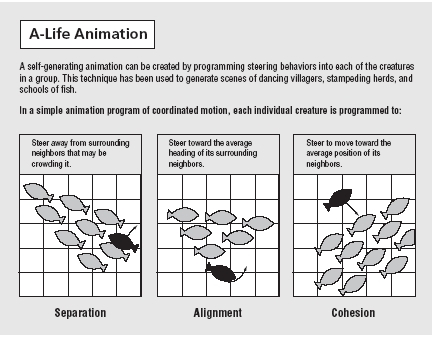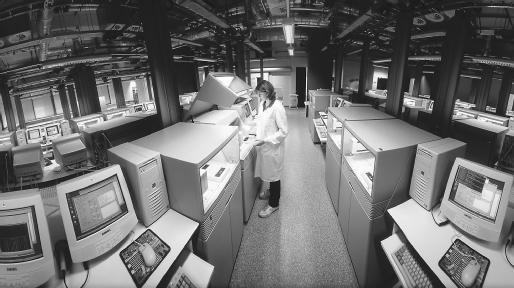Chapter 3
Everyday AI
The real success of AI is that most people are simply unaware of how significantly it affects and enables the routines of daily life. A man gets up in the morning to the smell of coffee already brewing. This is thanks to a microchip inside the coffee machine that allows him to program his coffeemaker to turn itself on while he is still sleeping. Another microchip keeps his toast from burning and remembers which setting from light to dark he likes best.
At one time these were all novel forms of AI. According to Douglas Hofstadter, a German researcher, "Once some mental function is programmed, people soon cease to consider it as an essential ingredient of 'real thinking.' AI is whatever hasn't been done yet." 8 Now that these features are commonplace, they are thought of as just another necessary product that makes life easier.
Already there are ovens on the market that keep food chilled until it starts to cook at a preset time. There are refrigerators with Web pads embedded in the doors to display recipes or to surf the Internet. The company iRobot now manufactures a robotic vacuum cleaner that buzzes around a room without a human operator.
But AI in the home today offers just a glimpse of what future household appliances will look like. "Most people don't realize fundamental changes in kitchen gear are coming. But in a decade or so, they won't know how they lived without their e-kitchens," 9 says

Bob Lamson, vice president of a company that makes high-tech gear. In the future, a cook may be able to place the ingredients on the kitchen counter and a built-in computer sensor will suggest recipes on the basis of those ingredients. Before leaving for work, a parent might place a frozen casserole in the oven and program it to defrost the casserole, then keep the dish chilled until it is time to start cooking. If traffic is tied up, the harried cook might simply be able to call the oven from the cell phone and reprogram the oven to delay dinner an hour. After dinner, family members might entertain themselves with one of the most sophisticated examples of AI in the home by playing a computer game.
Computer Games
Traditionally, AI computer programs have worked in the background, making sure that the digital environment of forests, smoking volcanoes, and rambling paths run smoothly. But AI is also used to make computer games more challenging for their human participants.
Most games are rule-based, which means that the computerized characters such as enemy guards, friendly wingmen, or monsters follow a basic set of rules according to what is happening around them. For example, if an enemy guard encounters a monster, it will attack the creature. If the creature flees, the enemy guard will chase after it, and if the enemy guard is fired on, it will dodge the bullet, spear, or laser ray. But these behaviors can become predictable for an experienced human player. By using AI, the computerized characters become less predictable and more difficult to overcome. Many designers incorporate fuzzy logic into the characters' decision-making programs so that the set of rules they operate under are less severe. All of the criteria do not have to be present for a character to act. There is flexibility in its behavior responses. Others use random weighting of certain attributes in order to create a more unanticipated chain of events.
More sophisticated games use AI software to analyze their human player's style of play. These programs actually learn to refine the game characters' social interactions so they can adapt to the human player's behavior. A game called Black and White God, designed by Richard Evans at Lionhead Studios, uses what he calls empathic learning to achieve this. In this game, if the human player throws fireballs at a tribal village, the computerized companion creature will learn that the player does not like the tribe. It will then act accordingly and spontaneously try to attack and stomp on that village's tribesmen.
Other games are goal based, which means that the computerized characters' behavior is determined by a larger preprogrammed goal. In Civilization III, by Firaxis Games, a player and various computer opponents fight military, economic, and cultural battles. The computerized opposition's goal is to stop the spread of the player's civilization by any means at their disposal. The characters' actions change depending on the obstacles put in their path.
Some of the most popular games are open-ended. Their characters do not have a finite path to follow or an ultimate goal. The top-selling game The Sims features a world of autonomous simulated people in an open-ended game where the human player oversees all the action. The characters, or Sims, interact based on a set of simple needs like food or entertainment. But the intelligence to interact with objects in the environment is not built into the Sims themselves. In a novel twist in programming, the objects in the environment advertise their ability to satisfy certain needs to any Sim character that is wandering by. The designer, Will Wright of Electronic Arts, calls this programming smart terrain. For example, when a Sim is looking around for fun, it may spot a beach ball. The Sim registers the beach ball's ability to satisfy its entertainment need. Wright explains, "All the instructions about how to bounce the ball are there as part of the ball's code." 10
Rather than taking more control over a game's design, game designers are giving more control to the human player. Software called middleware can be downloaded and used to direct certain aspects of the game. A player can make the game harder or easier to play. For example, the precise noise level that would normally activate an enemy guard's attack pattern can be tuned up or down so that a softly creaking door would not alert the guard, but a weapon firing nearby would give the player away.
All of these unique AI programs, originally designed for mindless popular entertainment, are finding their

way into the hands of the military for use in training videos and simulated war games used to predict the outcome of battles. But they are also used in the movies. Paul Kruszewki, president of BioGraphic Technologies in Montreal, says, "The film people want intelligent extras." 11
A-Life in Hollywood
Some crowd scenes in animated movies are created with computers and made more realistic with AI. Called artificial life or A-life, the process involves using a computer to mimic groups of living things. The artificial life forms follow a set of rules that govern a group of living creatures. A simplistic example would look like a piece of graph paper or a chessboard. A few of the squares would each contain a creature called a cellular automaton, which is governed by a basic set of rules. One rule might be that a creature with fewer than two neighbors dies. Another might be that a group of three creatures produces one new creature. The program is set into motion with the rules in place and the colony of A-life creatures multiplies, dies, and changes from generation to generation. A new generation occurs each time the computer analyzes what has happened and calculates the automata's new positions.
More sophisticated A-life look like primitive creatures milling about on a computer screen, chasing each other, hunting for food, mating, or fighting. In the movies A-life characters may appear in the pastel colors of animated fairy-tale characters in a Disney crowd scene or with the gruesome heads and bodies of a Middle Earth Orc, a character in the Lord of the Rings trilogy.


A-life programs allow the crowd of animated dancers in the final scene of Shrek II (2004) to move and twirl according to a set of guidelines that prevent them from bumping into each other. In early versions of the climax scene of the epic Lord of the Rings trilogy movie Return of the King (2003) the A-life forces of enemy Orcs kept running away. Each of the two hundred thousand computerized soldiers had been programmed to assess what was happening around them by drawing on their repertoire of military moves to fight the enemy. Unfortunately the A-life Orcs were smart enough to know they stood a better chance by dropping their weapons and fleeing. The A-life animators had to reprogram the Orcs specifically so they would stand and fight.
Driving AI
After seeing a movie, a family may hop into the car and again be confronted with more applications of AI at work. Electronic sensors throughout the car's engine monitor its efficiency. A neural network computer chip in newer models reduces the car's emissions and improves fuel efficiency by monitoring fuel combustion. Designed by the National Aeronautics and Space Administration's (NASA's) Jet Propulsion Laboratory, the chip can learn how to diagnose misfiring faster and alert the driver to engine problems.
In the 1990s, the U.S. Department of Transportation introduced the Intelligent Vehicle Initiative as part of the Transportation Efficiency Act for the 21st Century. Its mission is to look for ways to design cars and trucks that would prevent accidents and fatalities on the road. AI labs around the country are experimenting with all sorts of prototype AI systems, such as collision warning devices that use computerized voice, sound, or light to alert the driver to a possible crash and voice-activated controls so that the driver only has to push a single voice activation button on the steering wheel and command "Radio on" or "Temperature seventy degrees." Heat-detecting devices similar to the military's night vision systems would display infrared images on the windshield to warn drivers of an obstacle in their path. Sensors on the front of the car would allow the cruise control to maintain a safe speed and distance between vehicles by slowing or accelerating as needed.
"Smart cars" already give drivers the ability to navigate using the OnStar satellite system, which also automatically notifies emergency crews when an airbag has been deployed. The 2004 Toyota Prius even has sensors that can unlock the door when the driver's hands are full and help a driver safely back up into a parking space.
E-Commerce
Today a person does not have to get into a car to go shopping, thanks to sophisticated AI applications and the Internet. In 1995 almost no businesses conducted their affairs over the Internet. But by the year 2003 business-to-consumer sales on the Internet exceeded $100 billion and business-to-business sales more than $3 trillion.
As online purchasing booms, companies compete to find ways to maintain the growth of e-commerce and maximize their own market share and profits. One way is with an AI program called a collaborating filter. This software lets companies analyze their customers' buying patterns. The online bookstore Amazon.com, for example, uses collaborating filters to compare a person's buying patterns with those of other customers. Amazon then makes friendly recommendations of products tailored to a customer's peer preferences and profile. For example, someone who bought the latest Harry Potter novel may be offered a selection of books by the author Eoin Colfer, whose books are similar to J.K. Rowling's series. That suggestion is based on the knowledge that thousands of other people had previously purchased both. Even if a person does not buy online, the collaborative filtering engine keeps track of what products a person calls up on the viewing screen, so a buyer's potential purchases become part of the record.
Now when a person calls a company or logs on to a company's Web site, it is rare to actually contact a human being. Instead many businesses are relying on automated help desks that use an artificial intelligence system called case-based reasoning that works to match up the customer's problem to similar problems stored in its memory. It can then adapt a solution that worked in the past to the current problem.
But bypassing human-to-human interaction entirely has proven to have negative effects for businesses as well. Many people find computerized systems annoying and even alienating. A company called Extempo Systems in California seeks to alleviate this problem by offering so-called Expert Characters to guide a person through a Web site or a learning program. These Expert Characters, or Chatterbots, are digital characters who act like people and speak in a natural conversational style. They converse, listen, and interact, offering advice and guidance. Some Chatterbots will greet you when you visit a Web site and will even remember your product preferences from the last encounter.
AI in Business
AI is not just found in e-commerce. Expert systems help run most of the major businesses the world over. Wal-Mart harnesses an expert system enhanced with an ANN to sift through the data of all the sales at more than three thousand stores to find patterns and relationships between stores, products, and customers. It can find the pattern in what sells and what does not faster than hundreds of human analysts can. Expert systems even manage billions of dollars in the stock market.
The former editor of the Wall Street Journal , William Peter Hamilton, was a whiz at predicting movements in the stock market. His investment instincts beat the market by nearly 3 percentage points every year between 1930 and 1997. There was only one catch: Hamilton died in 1929! All of his amazing predictions were based on his knowledge but were produced by VirtualHamilton, another ANN expert system. A team of computer programmers mined Hamilton's writings to replicate his mindset. Then they fed the VirtualHamilton seventy years of market data to see how it would perform. It was a hit. Now more than $250 billion is managed using AI stock market software.
Another stock market strategy involves sophisticated genetic algorithms. The program starts by generating millions of sets of rules for buying and selling stock. The ones that beat the market go on to multiply and mutate to become better, while those that cannot beat the market are killed off. This is done millions of times over until those that survive are the best methods of buying and selling stock.
ANN expert systems are used not only to make money but to save money. The artificial neural networks compare existing patterns to previous situations and eventually "learn" what works and what does not as the program digests more and more data. They also can seek out connections between data that a human programmer may not have thought of. For this reason they are most useful in detecting credit and insurance fraud. According to the magazine Business Week , these ANN expert systems have slashed the incidents of credit card fraud by 70 percent for major credit companies. A credit card applicant's buying habits, income, number of children, and residence are fed into the system. The system is also given a description of the type of customers who have committed credit card fraud. Over time, as patterns change, the ANN expert system adapts and follows the new patterns that emerge to highlight those customers who are a good credit risk and those who are not.
The Digital Doctor
Expert systems are also used in medicine to help doctors diagnose patients. In a 1997 study researchers concluded that medical students learn more than 47,000 facts and 29,000 concepts in just the first two years of medical school. Ideally all of that knowledge can be programmed into an expert system.
One diagnostic expert system, MYCIN, helps diagnose certain blood infections. MYCIN was tested for accuracy by comparing it with diagnoses of five prestigious staff members of the Stanford School of Medicine. The doctors were each given ten case histories and asked to diagnose the patients on paper and give their recommendations. Researchers found that the MYCIN expert system performed significantly better than the human panel!
Other types of artificial intelligence are being used in medical research. Special machines that have been dubbed robot scientists can formulate hypotheses, design experiments, and interpret the results as well as human scientists can. Packed with sophisticated robotics so that they can pick up and mix test tubes filled with liquids, these machines are networked to several computers programmed with advanced AI.
Another AI medical machine scans biopsy slides normally viewed under a microscope by a technician. The tissue samples are checked for the appearance of abnormal cells that may signal cancer. A trained human technician can look at hundreds of slides a day, but a trained machine is able to view thousands more, working nonstop all day and all night. It automatically stores images of the most suspicious cells for human technicians to review and double-check. X-rays are checked in the same way. Technicians that use AI software in X-ray scanners have improved their detection rates to 90 percent or better. Researchers working on the Human Genome Project also use AI software to tease out the millions of molecules of genetic code.
From performing the most sophisticated medical tests to making the simplest cup of coffee, AI is there. When coupled with robotics, AI is even more impressive. One life-saving surgical tool called the Pathfinder is a robotic arm that can be programmed to perform brain surgery. Its movements are so precise that even a surgeon with the steadiest hands cannot duplicate them.

This sleek and petite robotic arm is a distant cousin to the much larger hydraulic robotic arms that are used in automobile assembly plants. The sophisticated robotics technology that now makes a surgeon's job easier and more precise got its start welding car parts on the floor of a Detroit factory in the 1950s. From that humble beginning, the science and engineering of robotics have taken many shapes and been incorporated even more into people's lives.
Also I was looking for some shocking statistics. Like '1 in every three homes has AI' or '97% of the population uses AI'. (they were completely made up)
Thank you so much!